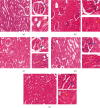Ruellia tuberosa L. Extract Improves Histopathology and Lowers Malondialdehyde Levels and TNF Alpha Expression in the Kidney of Streptozotocin-Induced Diabetic Rats
- PMID: 33110487
- PMCID: PMC7582068
- DOI: 10.1155/2020/8812758
Ruellia tuberosa L. Extract Improves Histopathology and Lowers Malondialdehyde Levels and TNF Alpha Expression in the Kidney of Streptozotocin-Induced Diabetic Rats
Abstract
Ruellia tuberosa L. is a therapeutic plant that is generally consumed in Indonesian traditional medicine to prevent or cure various illnesses, i.e., diabetes. The current study was conducted to investigate the effects of hydroethanolic root extracts of Ruellia tuberosa L. on the kidney of streptozotocin-induced diabetic Wistar rats. In this study, male Wistar rats were divided into 5 groups: healthy rats (group 1), diabetic rats (group 2), and treated rats which received extract at dosages of 250 (group 3), 375 (group 4), and 500 (group 5) mg/kg body weight for 21 days. Diabetes mellitus was experimentally induced by the administration of five doses of streptozotocin 20 mg/kg body weight within five consecutive days. Significant increases in the value of TNF alpha expression and malondialdehyde (MDA) levels were observed in streptozotocin-induced diabetes rats. Furthermore, severe histological alterations of kidney tissues occurred in the diabetic rats group. After treatment was applied, the value of TNF alpha expression and MDA levels on the kidney decreased considerably (p < 0.05) in groups 3, 4, and 5. The optimum dosage was obtained at a dose of 250 mg/kg body weight (group 3), which had 42.24% and 52.70% decrease in TNF alpha expression and MDA levels, respectively. The histopathological profiles of the kidney also showed significant improvements in treated groups. The most prominent recoveries were also shown in group 3. The treatments induced repairment in the glomerular and renal tubular damages in the kidney tissues. To conclude, these results emphasize potentially health valuable properties of hydroethanolic root extracts of R. tuberosa L. in rats with streptozotocin-induced diabetes.
Copyright © 2020 Anna Roosdiana et al.
Conflict of interest statement
The authors declare that they have no conflicts of interest.
Figures


Similar articles
-
Histopathological Profiles of Rats (Rattus norvegicus) Induced with Streptozotocin and Treated with Aqueous Root Extracts of Ruellia tuberosa L.Vet Med Int. 2021 Nov 10;2021:6938433. doi: 10.1155/2021/6938433. eCollection 2021. Vet Med Int. 2021. PMID: 34804472 Free PMC article.
-
Expression of TNF-α on Wistar Rat (Rattus norvegicus L.) with Extract of Pletekan Leaves (Ruellia tuberosa L.).Pak J Biol Sci. 2022 Sep;25(10):938-951. doi: 10.3923/pjbs.2022.938.951. Pak J Biol Sci. 2022. PMID: 36404748
-
Spondias tuberosa inner bark extract exert antidiabetic effects in streptozotocin-induced diabetic rats.J Ethnopharmacol. 2018 Dec 5;227:248-257. doi: 10.1016/j.jep.2018.08.038. Epub 2018 Sep 1. J Ethnopharmacol. 2018. PMID: 30176348
-
Effects of garlic extract on TNF-α expression and oxidative stress status in the kidneys of rats with STZ + nicotinamide-induced diabetes.Pharm Biol. 2017 Dec;55(1):526-531. doi: 10.1080/13880209.2016.1255978. Pharm Biol. 2017. PMID: 27937047 Free PMC article.
-
Effect of Ruellia tuberosa L. on aorta endothelial damage-associated factors in high-fat diet and streptozotocin-induced type 2 diabetic rats.Food Sci Nutr. 2019 Oct 9;7(11):3742-3750. doi: 10.1002/fsn3.1233. eCollection 2019 Nov. Food Sci Nutr. 2019. PMID: 31763023 Free PMC article.
Cited by
-
Antioxidative and Anti-inflammatory Effects of Plant-derived Hypoglycemic Medicines: An In vivo/In vitro Systematic Review.Curr Top Med Chem. 2024;24(16):1408-1450. doi: 10.2174/0115680266295032240415064750. Curr Top Med Chem. 2024. PMID: 38644706
-
Microencapsulation of Ruellia tuberosa L. Aqueous Root Extracts Using Chitosan-Sodium Tripolyphosphate and Their In Vitro Biological Activities.Scientifica (Cairo). 2022 Jun 1;2022:9522463. doi: 10.1155/2022/9522463. eCollection 2022. Scientifica (Cairo). 2022. PMID: 35692232 Free PMC article.
-
Histopathological Profiles of Rats (Rattus norvegicus) Induced with Streptozotocin and Treated with Aqueous Root Extracts of Ruellia tuberosa L.Vet Med Int. 2021 Nov 10;2021:6938433. doi: 10.1155/2021/6938433. eCollection 2021. Vet Med Int. 2021. PMID: 34804472 Free PMC article.
References
LinkOut - more resources
Full Text Sources

